-
Car Reviews
- All reviews
- Midsize SUVs
- Small cars
- Utes
- Small SUVs
- Large SUVs
- Large cars
- Sports SUVs
- Sports cars
- Vans
Latest reviews
- Car News
-
Car Comparisons
Latest comparisons
- Chasing Deals
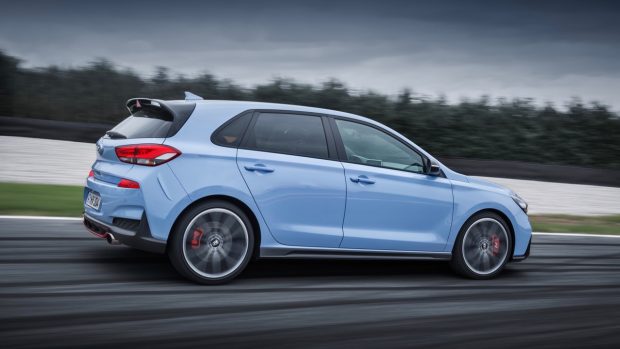
South Korea’s first genuine hot hatch, the 2018 Hyundai i30 N, is a front-wheel-drive, manual-only, would-be Volkswagen Golf GTI slayer. A monumentally important car for Hyundai’s development as a brand, the i30 N is the first of many future products from N, a dedicated performance division named after both Namyang, the home of Hyundai’s fast car development in Korea, and for the Nürburgring, where this car completed about 500 laps in the quest to get it right.
The N model follows the launch of the highly competent third-generation ‘PD’ i30 – a chassis that impressed us most in the warm, 150kW i30 SR form. But the i30 N, which packs up to 202kW from a beefier 2.0-litre turbo four, promises to be a whole different beast, bringing a number of serious performance technologies to the table, including an electronically-controlled, mechanically-locking limited slip differential, adjustable dampers, and active exhaust valves to the fore.
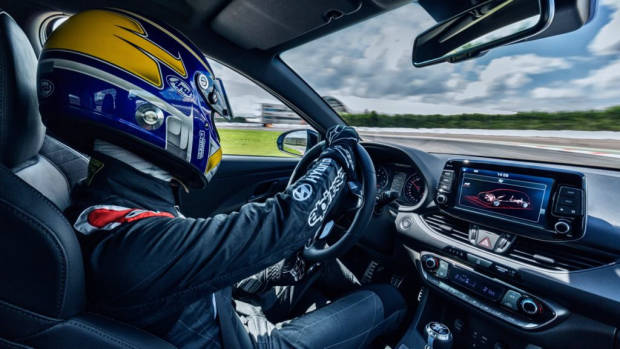
Taking a leaf out of Volkswagen’s playbook, the i30 N is in fact two cars: a more affordable version with 184kW of power and 353Nm of torque that foregoes features like the trick locking differential, and then a more expensive and more capable ‘Performance Package’ edition that turns up the taps to 202kW, adds bigger brakes, and more go-fast electronic gubbins.
But it’s a traditional manual gearbox that is the sole choice on both versions, with Hyundai predicting that a double-clutch automatic option is at least two years away. It is a gamble that will in the meantime sustain Volkswagen’s competitive advantage in building really usable, everyday hot hatches, but the manual-only attitude will also win Hyundai many fans.
A result of a believably gruelling development path that included long hours at Namyang, more than 10,000 kilometres of Nürburgring testing, plus two 24-hour races at the German track have resulted in a baby-blue hatch that carries far more than its own weight in aspiration. The i30 N is the first real result of not only that hard work, but also of Hyundai’s long-term talent acquisition programme that saw the Korean brand poach BMW’s vice president of M Engineering, Albert Biermann, and ex-BMW designer Thomas Bürkle to develop the car.
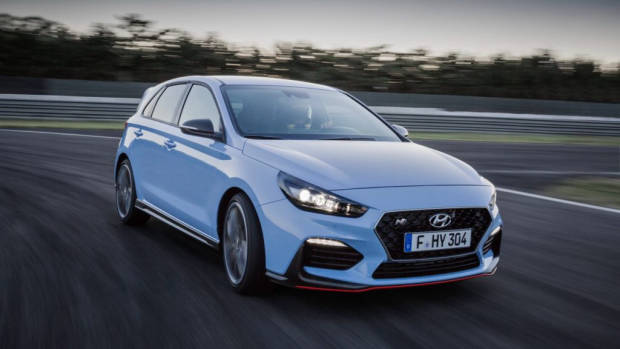
The i30 N carries the strongest European DNA yet from Hyundai, a brand that every year looks more like a ‘Eurasian’ brand than the small Korean carmaker it once was. Europe is home to substantial Hyundai production, and the i30 N will be built there too – rolling off the production line at the brand’s Czech factory in Nošovice. Each car will be subjected to an individual test on the Nošovice track to ensure the N engine, noise, and performance functions operate to the required standard before shipment.
The i30 N’s performance figures look impressive – 184kW compares favourably to a standard Golf GTI’s peak power of 169kW – but Hyundai are talking up a holistic focus that went into the i30 N’s development, over a preoccupation on ‘pure numbers’. There were three pillars of that development, that included track day capability, cornering prowess, and all-important everyday usability.
In standard form, the i30 N’s Theta-series two-litre turbocharged four-cylinder petrol makes 184kW of power and 353Nm of torque, sprinting to 100km/h in 6.4 seconds on the way to a maximum speed of 250km/h.
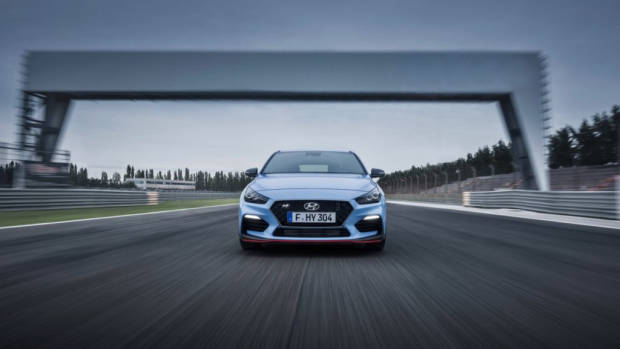
Adjustable dampers are standard, softening or tightening the springs on the McPherson strut front end and the multi-link rear end that showed real promise on the more mainstream i30 SR.
Five drive modes are available and are controlled by dedicated buttons on the blue-stitched, N-specific steering wheel – eco, normal and sport supplement two ‘chequered-flag’ modes called N and N Custom.
Switching into N mode loosens the electronic stability control – which can be switched completely off, too. N mode also allows the use of launch control, which automatically engages first gear by dumping the clutch anytime within a five second window of clutched, standstill full throttle.
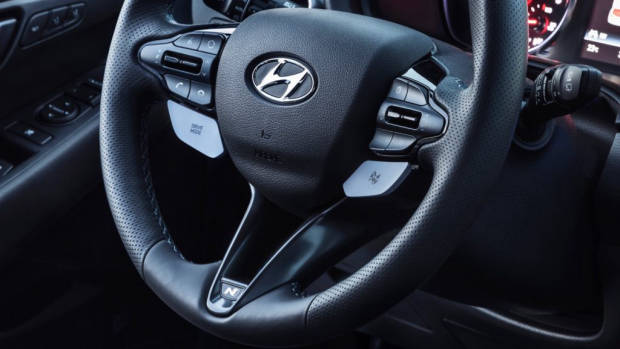
Also located on the steering wheel is a dedicated automatic rev matching button. When activated, rev matching will ‘blip’ the throttle on downshifts, imitating a perfect heel-toe manoeuvre at every shift. However, it can be turned off, allowing you to really drive this manual yourself.
The standard-form i30 N sits on 18-inch Michelin Pilot Super Sport rubber measuring 225/40R18. Those wheels cover standard brakes, though we don’t yet have a measurement on these.
But the Performance Package is the most desirable i30, at least until a full-fat, all-wheel-drive i30 RN arrives in future. The Performance edition adds about ten percent more power, taking the figure to 202kW, while torque is fixed at 353Nm. One-fifth of a second is shaved off the 0-100km/h time, taking it to 6.2 seconds.
Bigger, more serious rubber in the form of 19-inch Pirelli P Zero tyres adds more chemical grip. The Pirellis are a centimetre wider, measuring 235/35R19 at all four corners.
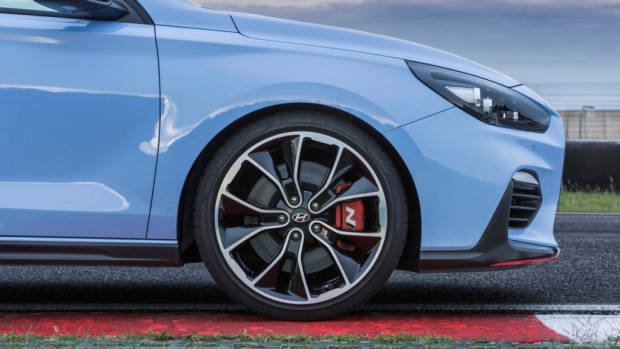
But it is an electronically-controlled, mechanically-locking limited slip differential on the front wheels that will make the difference to the Performance Package. We’ve seen this technology on cars like the Volkswagen Golf GTI 40 Years and the Alfa Romeo Giuletta Veloce, where it drastically increases the capability of a front-wheel-drive layout.
The differential, which allows the front wheels to turn at different speeds through a corner, reducing slip and minimising understeer, allows an uncanny ability to claw through and out of bends in the Volkswagen and Alfa Romeo. Given the time spent on the N’s development, it will be a big deal here, too.
A desirable active exhaust is also exclusive to the Performance Package, with driver-controlled variable valves taking the i30 N, in Hyundai’s words, from ‘normal to decidedly powerful’ in the aural department at the flick of a switch.
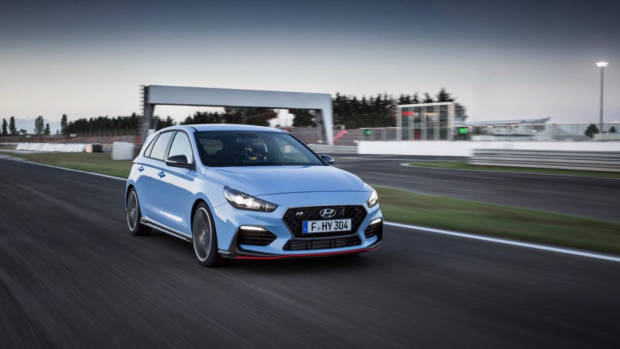
N mode, and the more harcore N Custom setting, will have their best effect in the Performance Package, where they not only adjust the steering weight, stability control, dampers and rev matching as in the base N, but also the differential and sound.
Larger brakes discs are a feature of the Performance Package – but all the extra gear mean it also weighs about 29 kilograms more than the standard car’s circa 1,450 kilogram kerb weight.
We were disappointed by the limited availability of advanced safety tech on manual-gearbox versions of the normal i30. The i30 N manages to correct some of this. There is still no radar cruise control, but it picks up the previously auto-only autonomous emergency braking and lane keep assist.
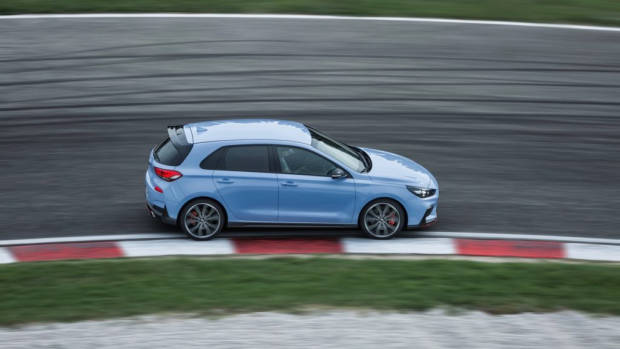
Sitting somewhere between the Golf GTI’s sleeper aesthetic and a shouty RenaultSport Megane RS, the i30 N identifies its performance credentials without looking too boy-racer. Unless you go for N division’s feature colour, that is: the light Performance Blue’ is a standout, though more conservative hues also sit on the six-strong palette.
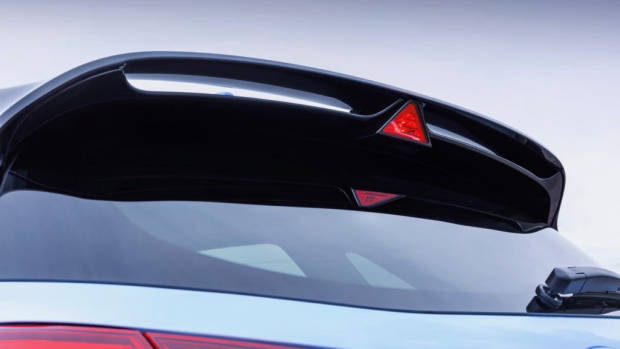
There are a few visual flourishes, most notably the F1-style triangular third brake light that sits in the prominent vented rear spoiler. The spoiler sits above the N’s aggressively-restyled rear bumper and diffuser, which makes more of an impact than the relatively mild front end distinguished by a red sill line and smoked headlight inserts.
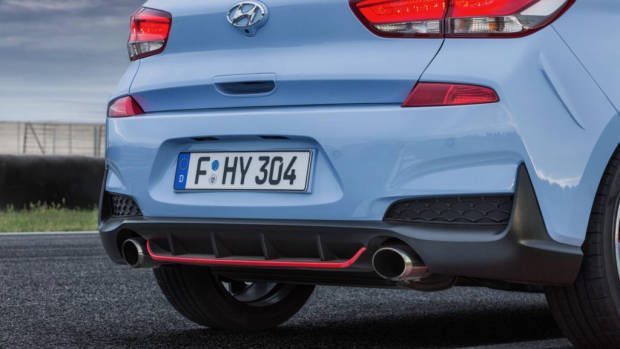
Large wheels, and the red-painted brake calipers of the Performance Package, pair to black side skirts to give the i30 N’s side profile a bit more bite. Plus, it’s lowered. On the standard car it drops 4 mm over a regular i30; the harder-bite Performance is 8 mm lower.
We liked the new ‘PD’ i30’s interior in standard form, and the N adopts this cabin with a number of useful performance additions – starting with far more serious seats, which are sculpted and heavily bolstered. In a signal of the BMW influence that ran through the vehicle’s development, they also include extendable lower seat cushions for long-legged drivers and front passengers. Cloth, or a suede-leather mix, will be available.
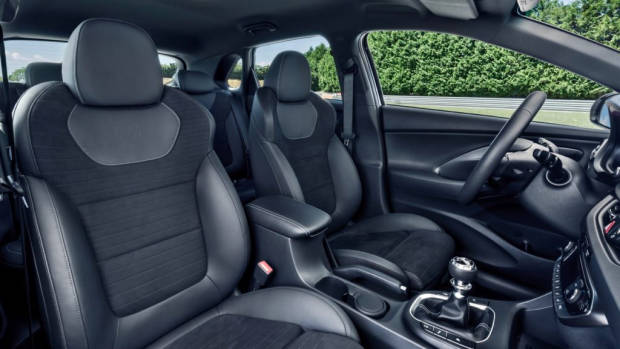
The steering wheel is unique but reminiscent of that used in the standard car. It’s differentiated by N-blue stitching, and by the prominent blue shortcut buttons for the sportier drive modes and the rev matching feature.
A short-throw gear shifter is capped with a ball top with the N logo and features a blue stripe – and blue also features in the analogue driver dials, which, like BMW’s M cars, features a dynamic rev limiter that changes in response to oil temperature.
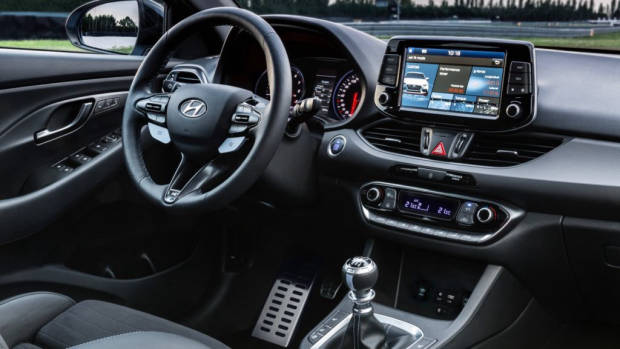
In Europe, a 5-inch touchscreen will be standard but we think it’s likely that the Australian specification will eschew this in favour of the 8-inch version standard on everyday i30s. The basic functions, including navigation and smartphone integration remain the same, but the N adds a lap timer, acceleration timer, and G-force meter.
The i30 N will arrive in Australia before the end of the year, and hopefully before the start of summer.
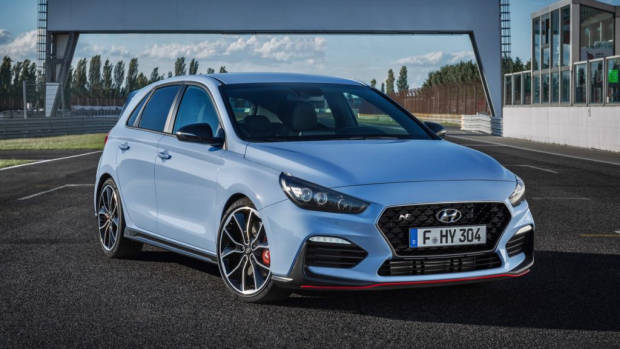
Hyundai’s local division has not yet announced what the Australian i30 N model lineup will be. We will either receive both the standard N and the Performance Package, or simply the Performance Package alone.
We’ll have the updates on hand as they come.
Latest news
About Chasing cars
Chasing Cars reviews are 100% independent.
Because we are powered by Budget Direct Insurance, we don’t receive advertising or sales revenue from car manufacturers.
We’re truly independent – giving you Australia’s best car reviews.